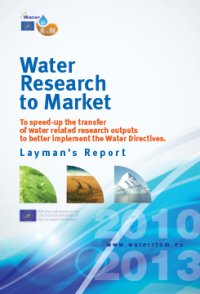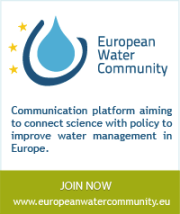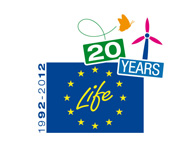AMAP
| Output characterisation | |
| OUTPUT SENTENCE | Procedure for testing the catalytic performances of the advanced catalytic materials for selective reduction of nitrate/nitrite ions to nitrogen in aqueous phase. |
| OUTPUT TYPE | methodology |
| WATER TOPIC | Quality of natural systems |
| KEYWORDS | surface water and groundwater, Quality of natural systems, Urban pollution, Industrial pollution, Agricultural pollution |
| KEYWORDS TYPE | methodology, procedure. |
| MARKET NEED TAILORED | Water Framework Directive; Wastewater Directives - Reduction of water pollution |
| OUTPUT DESCRIPTION | One of the most spread pollutants in the surface and deep waters are the nitrate and nitrite ions. High levels of nitrate/nitrites in drinking water increase the incidence of serious diseases of human beings such as cancer, and kidney diseases. The abatement of nitrate and nitrites in polluted waters is of great importance, the admitted level in the drinking water being 50 mg/L. One of the proposed solution in this project was the catalytic reduction of nitrate ions on bimetallic nanoparticles having a controlled morphology, structure and chemical state. By this strategy the following practical problems were intended to be solved: (I) increase in the catalytic activity (conversion), (II) in the selectivity to N2 and (III) in the stability in time. At present, the catalysts exhibit low conversions and high selectivity for NH3 formation (the accepted limit is up to 0.5 mg/L) and high deactivation rate. The catalyst development strategy took into account that the catalytic reduction of NO3-/NO2- to N2 is a structure sensitive reaction involving the making of N-N bond. As a consequence, the catalytic active phase (supported metal/bimetal) must have optimum, well-defined morphology. In other words, the size as well the structure (core-shell or alloy) of the metal particles should be controlled so to direct the reaction to the selective formation of N2 instead of NH3. Another important fact that was not taken enough under consideration is the support porosity. An ideal pore structure assumes facile diffusion of reactants at active sites and products from internal pores in reaction medium. So, an ideal catalytic support has to present an ordered porosity with an average pores dimension of nanometers range. The advantages of this kind of support materials are: (I) high specific surface area values that determine an optimal dispersion of catalytic active phase and (II) facile diffusion through the pores of reaction species. The rigorous control of morphology of both metallic species and support allows the design of new advanced material architectures, leading hopefully to the significant improvement of catalytic performances. The main objectives of the proposal are related to: (I) the implementation and optimization of modern green techniques for synthesis of nanomaterials (oxides and metals) with a controlled morphology (ordered pores structure, particle sizes, geometrical shape) and (II) the utilization of these materials in catalytic processes for reducing of environmental pollution. The practical proposed solutions are: (i) the use of reverse microemulsions technique to produce alumina-based nanooxides with controlled morphology, (II) the preparation of mono/bimetallic nanoparticles (Pt-M, Pd-M, Rh-M; M=Cu, Ag) with controlled morphology by polyol method, (III) the obtaining ordered architectures with high catalytic activity and selectivity by assembling the ordered mesoporous structures with metallic nanoparticles, (IV) catalytic tests for selective reduction of NO3- and NO2- to nitrogen with hydrogen and (V) the possibility to investigate in deepth the correlation between catalytic performances and morphology (specific surface are, average pores diameter and particle size) in order to develop viable strategies for synthesizing catalytic materials with better performances. |
| STATE OF DEVELOPMENT | Laboratory scale equipment. |
| INNOVATIVE ASPECTS AND ADVANTAGES | Mono and bimetallic nanoparticles Pt, Pt-Cu, Pt-Ag, Pd, Pd-Cu, Pd-Ag, Rh, Rh-Cu si Rh-Ag with controlled morphology, structure and chemical state assembled with mesoporous nanooxides ordered architectures have been used for the first time for denitration reaction. Catalytic materials are dedicated for environmental protection technologies, namely the removal of nitrites and nitrates from drinking and/or industrial waters. The preparation methods of catalytic materials are eco-friendly (green technology). After the operation cycle, the spent catalytic materials can be recovered and completely recycled. |
| INTELLECTUAL/INDUSTRIAL PROPERTY RIGHTS | The final products (materials and technology) will be available to the end users based on a license specifying the conditions (copyright and taxes). |
| TRANSFERABILITY | - it is possible to transfer results in other territories ? - It is possible to transfer results/nanomaterials (bimetallic nanoparticles with controlled morphology and structure) in other domains such as energy (hydrogen storage), other depolution proceses (NOx abatement from exhausted gases, removal of chlorinated organic water pollutants), fuel cells (catalytic oxidation of methanol), biomedicine (“Drug Delivery “, DNA analysis), biosensors. |
| POTENTIAL USERS/CLIENTS | Research, Medium and Large Scale Entreprises. |
| Estimation of risks | |
| EVALUATION OF RISKS FOR OUTPUT USERS | At present, our research answers to a real need for reduction of water pollution. Probably that at the beginning the most feasible would be the manufacturing of small devices for treatment of water in hospitals or economic units as well as the built of small water treatment units in locations with high pollution. ?Risks are related to low demand, high production costs relative to benefits, the drawbacks related to catalytic materials ( deactivation, low activity, poor selectivity). The shortcomings coming from materials and technology can be solved by continuation of the research activity. |
| ECONOMICAL RISKS | high production costs relative to benefits |
| TECHNICAL RISKS | In present the device are not ready for the market (testing, improvement, prototype development are needed) |
| MARKET RISKS | low demand of market |
| Steps ahead | |
| NEXT STEPS TO ACHIEVE THE STATUS 'READY TO USE' |
|
| TYPE OF PARTNER FOR THE NEXT DEVELOPMENTS | SMEs involved in treatment polluted water, companies manufacturing small filtering and treatment devices for drinking water originating from wells as well as tap |
| TASKS TO BE PERFORMED | Small-scale (laboratory) tests |
| COLLABORATION DETAILS |
|
| Estimation of ressources | |
| RESOURCES FOR NEXT STEPS | Our estimation is that at least 3 years would be necessary to put on the market the catalytic materials and the related technology for removing nitrites and nitrates from drinking or industrial waters. Our research was an exploratory, pioneering one because up to now, supported bimetallic nanoparticles have not been used for the denitration of polluted waters. |
| FORESEEN COSTS FOR NEXT STEPS | Necessary expenses can be divided as follows: 1. Costs for development refers to the research neccesary for finding the ideal morphology (particle size and geometry), structure (core-shell or alloy) and chemical state (oxidation state) of the bimetallic nanoparticles in order to maximize the selectivity and catalytic activity. Improvement costs include the costs of catalytic materials (eg. noble metals), materials characterization costs and personel costs. 2. Costs of catalyitc tests: catalytic tests include consumables (gas, eluents, etc.) and personnel costs. 3. Costs of producing a working prototype: implementation of a cartridge-type filter for removing nitrites and nitrates from water. At present moments it is difficult to assess the total costs for the activities listed above. However, we estimate that an amount of 50 000 Ron (12 000 euro)/ year would be sufficient. |
| Contact | |
| TECHNICAL CONTACT | PhD. Balint Ioan |
| COUNTRY | ROMANIA |
| WEBSITE | http://www.icf.ro/PN_II/AMAP/index.html |
| WATER RTOM CONTACT | CFPPDA |
| Background | |
| PROJECT NAME | Advanced material architectures and their application for the treatment of polluted waters |
| PROJECT ACRONYM | AMAP |
| PROJECT DESCRIPTION | One of the most spread pollutants in the surface and deep waters are the nitrate and nitrite ions. High levels of nitrate/nitrites in drinking water increase the incidence of serious diseases of human beings such as cancer, and kidney diseases. The abatement of nitrate and nitrites in polluted waters is of great importance, the admitted level in the drinking water being 50 mg/L. One of the proposed solution in this project was the catalytic reduction of nitrate ions on bimetallic nanoparticles having a controlled morphology, structure and chemical state. By this strategy the following practical problems were intended to be solved: (I) increase in the catalytic activity (conversion), (II) in the selectivity to N2 and (III) in the stability in time. At present, the catalysts exhibit low conversions and high selectivity for NH3 formation (the accepted limit is up to 0.5 mg/L) and high deactivation rate. The catalyst development strategy took into account that the catalytic reduction of NO3-/NO2- to N2 is a structure sensitive reaction involving the making of N-N bond. As a consequence, the catalytic active phase (supported metal/bimetal) must have optimum, well-defined morphology. In other words, the size as well the structure (core-shell or alloy) of the metal particles should be controlled so to direct the reaction to the selective formation of N2 instead of NH3. Another important fact that was not taken enough under consideration is the support porosity. An ideal pore structure assumes facile diffusion of reactants at active sites and products from internal pores in reaction medium. So, an ideal catalytic support has to present an ordered porosity with an average pores dimension of nanometers range. The advantages of this kind of support materials are: (I) high specific surface area values that determine an optimal dispersion of catalytic active phase and (II) facile diffusion through the pores of reaction species. The rigorous control of morphology of both metallic species and support allows the design of new advanced material architectures, leading hopefully to the significant improvement of catalytic performances. The main objectives of the proposal are related to: (I) the implementation and optimization of modern green techniques for synthesis of nanomaterials (oxides and metals) with a controlled morphology (ordered pores structure, particle sizes, geometrical shape) and (II) the utilization of these materials in catalytic processes for reducing of environmental pollution. The practical proposed solutions are: (i) the use of reverse microemulsions technique to produce alumina-based nanooxides with controlled morphology, (II) the preparation of mono/bimetallic nanoparticles (Pt-M, Pd-M, Rh-M; M=Cu, Ag) with controlled morphology by polyol method, (III) the obtaining ordered architectures with high catalytic activity and selectivity by assembling the ordered mesoporous structures with metallic nanoparticles, (IV) catalytic tests for selective reduction of NO3- and NO2- to nitrogen with hydrogen and (V) the possibility to investigate in deepth the correlation between catalytic performances and morphology (specific surface are, average pores diameter and particle size) in order to develop viable strategies for synthesizing catalytic materials with better performances. |
| LEADER | "Ilie Murgulescu" Institute of Fpysical Chemistry |
| TEAMS INVOLVED | Institute of Physical Chemistry - Dr. Ioan Balint ?University POLITEHNICA of Bucharest - Daniela Berger ?INCDFM - National Institute of Materials Physics - Dr. Mihai Lazarescu |
| COUNTRIES INVOLVED | ROMANIA |
| PROJECT LOCATION | RO |
| FUNDING ORGANISATION | CNMP |




